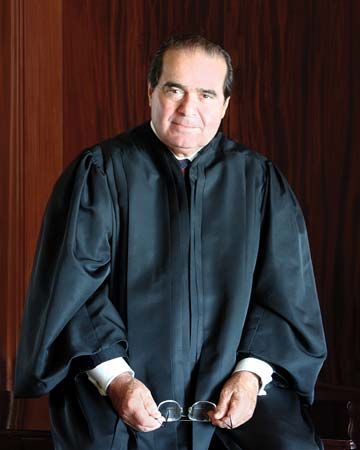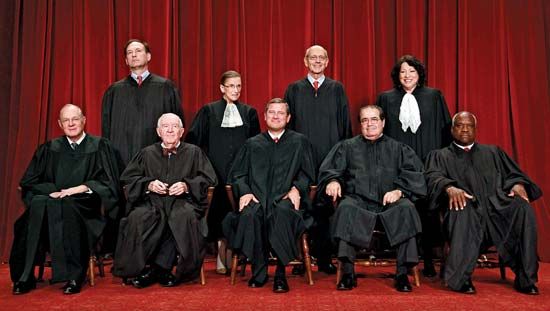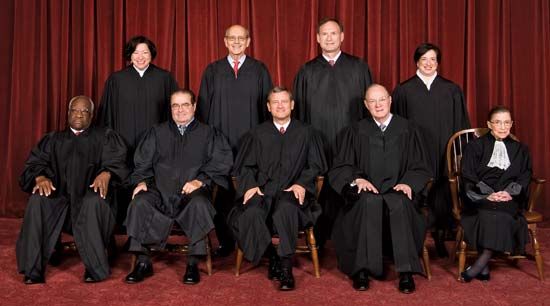Antonin Scalia
Our editors will review what you’ve submitted and determine whether to revise the article.
- NPR - Justice Antonin Scalia, Known For Biting Dissents, Dies At 79
- Oyez - Biography of Antonin Scalia
- The Guardian - Antonin Scalia: man of his word who shaped America in life and in death
- Acton Institute - Antonin Scalia’s Rise to Greatness
- Free Speech Center at Middle Tennessee State University - Antonin Scalia
- Legal Information Institute - Antonin Scalia
- Born:
- March 11, 1936, Trenton, New Jersey, U.S.
- Died:
- February 13, 2016, Shafter, Texas (aged 79)
- Title / Office:
- Supreme Court of the United States (1986-2016), United States
Antonin Scalia (born March 11, 1936, Trenton, New Jersey, U.S.—died February 13, 2016, Shafter, Texas) was an associate justice of the Supreme Court of the United States from 1986 to 2016, well known for his strong legal conservatism. He was the first Supreme Court justice of Italian ancestry.
Education and early career
Scalia’s father, a Sicilian immigrant, taught Romance languages at Brooklyn College, and his Italian American mother taught elementary school. Scalia attended a Roman Catholic high school in New York City and graduated at the top of his class from Georgetown University (A.B., 1957) in Washington, D.C. He attended Harvard Law School, where he edited the prestigious Harvard Law Review and graduated in 1960. He then worked for a law firm in Cleveland, Ohio (1961–67), before moving to Charlottesville, Virginia, where he taught at the University of Virginia School of Law (1967–74). During his tenure at Virginia, he served the federal government as general counsel to the Office of Telecommunications Policy (1971–72) and as chairman of the Administrative Conference of the United States (1972–74). In 1974 Scalia left academia to serve as assistant attorney general in the Office of Legal Counsel of the U.S. Department of Justice.
Scalia resumed his academic career at Georgetown University (1977) and the University of Chicago Law School (1977–82). For part of the latter period he served as editor of Regulation, a review published by the conservative American Enterprise Institute. In 1982 President Ronald Reagan nominated him to the U.S. Court of Appeals for the District of Columbia Circuit. Nominated by Reagan to the Supreme Court in 1986, he won unanimous confirmation in the U.S. Senate.
Judicial philosophy
An opponent of so-called “judicial activism,” the alleged tendency of some judges to usurp the power of elected legislatures by making the law rather than merely interpreting it, Scalia favoured a restrained judiciary, deference to the original public meanings of legislative and constitutional texts, and a limited role for the federal government. Scalia admonished judges whom he viewed as insufficiently committed to a well-developed judicial philosophy, a failure he believed would invite judging that was improperly based on personal preferences and biases. For his own part, Scalia endorsed fixed-meaning modes of interpretation: “originalism” in cases involving the Constitution and “textualism” (a method that he helped to establish) in cases involving statutory interpretation. According to these approaches, the meaning of a legal text should be determined not by examining the intentions or purposes of the drafters (even when these are well documented) but rather by consulting the common understanding of the terms in which the text was written at the time it went into effect. According to Scalia, for example, the Eighth Amendment’s prohibition of “cruel and unusual punishment” cannot be interpreted as inconsistent with capital punishment, because death was a common punishment for felonies when the Bill of Rights was ratified (1791). For Scalia, such interpretive methods were essential to minimizing the judiciary’s role in resolving matters that should be left to democratic processes.
Scalia’s jurisprudence inspired volumes of criticism from other judges and legal scholars who argued that drawing bright lines on the basis of a strict reading of legal texts amounted to a rejection of the art and craft of good judging. Critics also complained that the historicism required by Scalia’s methods did not identify a single best interpretation any more readily than other approaches and consequently left just as much room for judges to base decisions on personal beliefs. Thus, whereas Scalia’s majority opinion in District of Columbia v. Heller (2008) found that Washington, D.C.’s ban on handguns was unconstitutional because the original meaning of the text of the Second Amendment protected an individual right to bear arms independent of service in a state militia, Justice John Paul Stevens’s dissenting opinion relied on a similar historical analysis to draw exactly the opposite conclusion. Scalia did not deny the validity of such critiques, but he argued that his approach was nevertheless superior to any other method at reducing inappropriate influences on judges’ decisions.

Scalia was known for his generally conservative legal opinions. He consistently favoured gun rights, state support of religion, and states’ rights while opposing abortion rights, affirmative action, and civil rights protections for historically disadvantaged groups. In a time of rapidly changing public views regarding the morality and legality of same-sex relationships, Scalia also clearly and consistently proclaimed that the Constitution afforded no protections on the basis of sexual orientation. He was frequently criticized for his perceived insensitivity and even hostility toward homosexuals. One such opinion that drew widespread condemnation was his dissent in Lawrence v. Texas (2003), in which the court had struck down a Texas antisodomy law as an unconstitutional invasion of privacy. Reading from the bench (to emphasize the importance of his opinion), Scalia accused his colleagues of having “taken sides in the culture war” and of having “signed on to the so-called homosexual agenda.”
Off the bench, some of Scalia’s activities and remarks also fueled criticism that his legal opinions were motivated by conservative political ideology. He appeared to relish his role as the brightest star of the conservative legal movement, and he regularly spoke at gatherings of the Federalist Society, an influential organization of conservative and libertarian legal professionals. He also admitted late in life that his news sources consisted almost exclusively of conservative outlets, including conservative talk radio.
But Scalia’s opinions sometimes deviated from conservative policy and preferences in important ways, particularly with regard to the civil liberties protected in the Bill of Rights. In Texas v. Johnson (1989) and United States v. Eichman (1990), for example, he joined narrow majorities that struck down bans on flag burning on free-speech grounds, despite his professed sympathy toward such laws. In a series of decisions, he declared unconstitutional under the Fourth Amendment (which guarantees the right against “unreasonable searches and seizures”) various tactics by law-enforcement officials, including the use of thermal-imaging technology to penetrate a home’s walls (Kyllo v. United States [2001]), attaching a GPS device to a car to track a suspect’s movements (United States v. Jones [2012]), and allowing a drug-detection dog to sniff at a suspect’s front door (Florida v. Jardines [2013]). Another of Scalia’s opinions that upset many conservatives was his ruling for the majority in Employment Division v. Smith (1990), which reduced the level of scrutiny that courts needed to apply in considering the validity of government restrictions on the free exercise of religion.
Scalia believed that constitutional requirements imposed a rigidity on the democratic process by removing certain policies from consideration by voters and legislators. He recognized and vigorously supported those constitutional constraints that he considered to be well established in historical practice. Such constraints included: (1) limits on federal power and guarantees of state sovereignty—e.g., his majority opinion in Printz v. United States (1997), in which he held that the federal government could not require state and local law-enforcement agencies to perform background checks on prospective gun owners; (2) the checks and balances imposed by the separation of powers—e.g., his lone dissent in Morrison v. Olson (1988), in which he held that the Independent Counsel Act (1978) infringed on powers that the Constitution provided exclusively to the executive branch; and (3) the individual rights articulated in the Bill of Rights—e.g., his majority opinion in Crawford v. Washington (2004), which found that the use of out-of-court statements by witnesses who are not present at trial violates the Sixth Amendment’s confrontation clause (which protects the right of criminal defendants to confront the witnesses against them). Scalia believed that issues that fell outside such constraints should be left for democratic deliberation or constitutional amendment rather than being decided by judges. Accordingly, he was generally unwilling to recognize constitutional protections for unenumerated rights, or rights not explicitly mentioned in the Constitution.



















